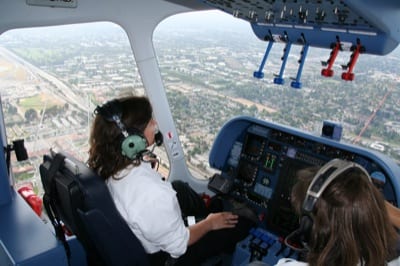I am enamored with airships, so when I found out that Airship Ventures, a start-up company in the San Francisco Bay area, was offering a chance to pilot one, I had to take advantage of the offer.
Airship Ventures was started in 2006 by Brian and Alexandra (Alex) Hall. Brian’s background is in project development and Alex’s is in marketing. Both are aviation fans and self-proclaimed “helium heads.”
The company is based at Moffett Field (NUQ) in Sunnyvale, Calif. The airport, an old military base, has three of the remaining airship hangars in the United States.
The zeppelin has been in the U.S. since the beginning of 2009. Airship Ventures has given about 1,000 rides so far in the 246-foot ship, which was built by the Zeppelin Co. in Germany and is known as a Zeppelin NT for new technology.
Besides offering aerial tours, Airship Ventures also offers a two-day airship pilot experience. Classes, which are limited to six people, include a one-day ground school and a day of flying.
The experience began with a meet and greet at Airship Ventures’ offices located in the old bachelor officers quarters at Moffett. After meeting our instructors — Kate Board from England and Fritz Goenther from Germany — we went to the hangar to see the ship. The Zeppelin is kept in one of the smaller hangars across from Hangar One, the behemoth built for the dirigible USS Macon.
The ship was moored to the mast truck. There is a tailwheel on the Zeppelin but no bottom fin. The modern Zeppelin has a rear-mounted engine. Thrust is generated by propellers. The pilot vectors the thrust with a lever in the cockpit.
We were each issued a copy of the airship technical manual to accompany the five-hour ground school. Goenther, using a model of the ship and a white board, explained how to keep the ship in trim using the ballonets, repositioning of fuel and water ballast.
We learned the technical aspects of the ship, such as managing the helium and air in the balloonets to control lift, and how the propellers rotate to control thrust. We learned how to load and unload passengers. We also learned that when the ship gets lighter because of fuel burn, the ground crew adds shot bags to compensate for the lighter weight. Helium is not dumped unless it is absolutely necessary because it is expensive.
Zeppelins are very weather dependent. We were slated to launch around 7 a.m. The fog, so prevalent in the San Francisco Bay area was of concern, but we lucked out and the weather was good enough for flying.
The preflight briefing included information on exits and the use of seatbelts and life preservers. We had already undergone security background checks, but we were instructed to leave behind cutting implements, lighters and cellphones. We were then security wanded and driven out to the hangar.
As we stood on the ramp the alarm sounded and the hangar door slowly opened. The ship, attached to the mast truck, moved out slowly and majestically.
Keep in mind that the ship is dynamic, even when attached to the mast. It can move in a circle when the wind hits it so you have to REALLY pay attention when loading or offloading because it can shift on you.
The ship, designed for single pilot operation, is flown with a side-stick. It’s more sensitive than the side-stick on a Cirrus, but less sensitive than the stick on a Cub.
The left side of the panel has glass instruments. The steam gauge backup instruments are on the right side. I had never seen that type of glass presentation before and spent a few minutes finding the vertical speed indicator and the like.
I have to apologize to my classmates for doing a 10+° pitch up on take off. Climb-out is much different in an airship than it is in an airplane. You have more than 200 feet of ship behind you when you do pitch up. Board had us all pitch up 10° then look over our shoulders to see the dramatic deck angle. The ship does roll, because it is a ship. There aren’t any rudder pedals.
If you turn steeply, the airspeed reduces. When you consider that you aren’t going much faster than 40 mph, everything is slow.
We flew over the airport. Each student got to do climbs, turns, descents, takeoffs and landings. Then Goenther demonstrated the limitations of the airship in climbs and descents.
It was magical. I wished that my father, the airship fanatic and retired aerospace engineer, could be there, but because of class limitations it could not be done. I wore his dog tags on the flight so he was there with me in spirit.
At the end of the day our logbooks were signed and we received certificates of experience. We then toasted with champagne, saying “UP SHIP!” the traditional call when an airship is launched.
The two-day experience costs $2,950. All participants must have a valid FAA medical and at least a private pilot’s license.
For more information: AirshipVentures.com.
